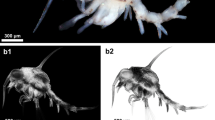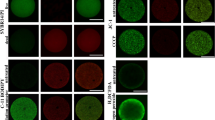Abstract
Confocal laser scanning microscopy (CLSM) represents a powerful, but largely unexplored ecotoxicologic tool for rapidly assessing in vivo effects of toxicants on marine invertebrate embryo quality and development. We describe here a new semiquantitative CLSM approach for assessing relative yolk quantity in marine invertebrate embryos (harpacticoid copepods) produced by parents reared from hatching to adult in the polycylic aromatic hydrocarbon chrysene. This method is based on fluorogenic labeling of embryo yolk and subsequent statistical analysis of areal pixel intensities over multiple Z-series using a general linear model (GLM)–nested analysis of variance. The fluorescent yolk-labeling method described here was able to detect statistically significant differences in yolk concentrations in marine copepod (Amphiascus tenuiremis) eggs or embryos from females exposed to ultraviolet light and chrysene-contaminated sediments. Yolk intensities in embryos from females cultured throughout their life cycles in clean sediments were statistically identical with or without UV exposure. In constrast, yolk intensities in embryos of females cultured throughout their life cycle in chrysene-contaminated sediments were significantly higher in the non-UV-exposed treatment with chrysene at 2500 ng/g sediment (65.7% higher) and the UV-exposed treatment with chrysene at 500 ng/g sediment (76.6% higher).




Similar content being viewed by others
References
G.T. Ankley S.A. Collyard P.D. Monson P.A. Kosian (1994) ArticleTitleInfluence of ultraviolet light on the toxicity of sediments contaminated with polycyclic aromatic hydrocarbons. Environ Toxicol Chem 13 1791–1796 Occurrence Handle1:CAS:528:DyaK2cXmslGnu7w%3D
InstitutionalAuthorNameASTM (1989) Standard Guide for Conducting Acute Toxicity Tests with Fishes, Macroinvertebrates, and Amphibians. American Society for Testing and Materials, E-729 88a. West Conshohocken, Pa.
B.L. Boese R.J. Ozretich J.O. Lamberson F.A. Cole R.C. Swartz S.P. Ferraro (2000) ArticleTitlePhototoxic evaluation of marine sediments collected from a PAH-contaminated site. Arch Environ Contam Toxicol 38 274–282 Occurrence Handle10.1007/s002449910037 Occurrence Handle1:CAS:528:DC%2BD3cXhvFaitL4%3D Occurrence Handle10667924
G.T. Chandler A.S. Green (1996) A 14-day harpacticoid copepod reproduction bioassay for laboratory and field contaminated muddy sediments. G.K. Ostrander (Eds) Techniques in Aquatic Toxicology CRC Press, Inc. Boca Raton, Fla.
G.T. Chandler A.S. Green (2001) ArticleTitleDevelopmental stage-specific life-cycle bioassay for assessment of sediment-associated toxicant effects on benthic copepod production. Environ Toxicol Chem 20 171–178 Occurrence Handle1:CAS:528:DC%2BD3MXitl2j Occurrence Handle11351405
M.S. Cooper L.A. D’Amico C.A. Henry (1999) ArticleTitleAnalyzing morphogenetic cell behaviors in vitally stained zebrafish embryos. Methods Mol Biol 122 185–204 Occurrence Handle1:STN:280:DyaK1M3kvVGktw%3D%3D Occurrence Handle10231793
G. Cox (1999) ArticleTitleMeasurement in the confocal microscope [review]. Methods Mol Biol 122 357–371 Occurrence Handle1:STN:280:DyaK1M3kvVGrsQ%3D%3D Occurrence Handle10231801
A.R. Fortner M. Sanders S.W. Lemire (1996) Polynuclear aromatic hydrocarbon and trace metal burdens in sediment and the oyster, Crassostrea virginica Gmelin, from two high-salinity estuaries in South Carolina. F.J. Vernberg W.B. Vernberg T.S. Siewicki (Eds) Sustainable Development in the Southeastern Coastal Zone University of South Carolina Press Columbia
A.S. Green G.T. Chandler B.C. Coull (1995) ArticleTitleAge-specific survival analysis of an infaunal meiobenthic copepod, Amphiascus tenuiremis. Mar Ecol Prog Ser 15 29–40
T. Hagopian-Schlekat G.T. Chandler TJ. Shaw (2001) ArticleTitleAcute toxicity of five sediment-associated metals, individually and in a mixture, to the estuarine meiobenthic harpacticoid copepod Amphiascus tenuiremis. Mar Environ Res 51 247–264 Occurrence Handle10.1016/S0141-1136(00)00102-1 Occurrence Handle1:CAS:528:DC%2BD3MXhvVektL4%3D Occurrence Handle11468968
G.R.F. Hicks B.C. Coull (1983) ArticleTitleThe ecology of marine meiobenthic harpacticoid copepods. Oceanogr Mar Biol Annu Rev 21 67–175
L. Jin D.Q. Tran C.F. Ide J.A. McLachlan S.F. Arnold (1997) ArticleTitleSeveral synthetic chemicals inhibit progesterone receptor-mediated transactivation in yeast. Biochem Biophys Res Commun 233 139–146 Occurrence Handle10.1006/bbrc.1997.6417 Occurrence Handle1:CAS:528:DyaK2sXislCksb8%3D Occurrence Handle9144411
J.A. Kreiling R.E. Stephens A.M. Kuzirian K. Jessen-Eller C.L. Reinisch (2000) ArticleTitlePolychlorinated biphenyls are selectively neurotoxic in the developing Spisula solidissima embryo. J Toxicol Environ Health 61A 657–675 Occurrence Handle10.1080/00984100050195143
K. Lang (1948) Monographie der Harpacticiden. Hakan Ohlsson Lund, Sweden
J.S. Miller D. Olejnik (2001) ArticleTitlePhotolysis of polycyclic aromatic hydrocarbons in water. Wat Res 35 233–243 Occurrence Handle10.1016/S0043-1354(00)00230-X Occurrence Handle1:CAS:528:DC%2BD3cXotVehtb8%3D
W.A. Mohler J.G. White (1998) ArticleTitleStereo 4-D reconstruction and animation from living fluorescent specimens. Biotechniques 24 1006–1012 Occurrence Handle1:CAS:528:DyaK1cXjslKrt7w%3D Occurrence Handle9631195
W.A. Mohler J.S. Simske E.M. Williams-Masson J.D. Hardin J.G. White (1998) ArticleTitleDynamics and ultrastructure of developmental cell fusions in Caenorhabditis elegans hypodermis. Curr Biol 8 1087–1090 Occurrence Handle1:CAS:528:DyaK1cXmsVGktrY%3D Occurrence Handle9768364
G.H. Monteverdi R.T. Di Giulio (2000) ArticleTitleIn vitro and in vivo association of 2, 3, 7, 8-tetrachlorodibenzo-p-dioxin and benzo[a]pyrene with the yolk-precursor protein vitellogenin. Environ Toxicol Chem 19 2502–2511 Occurrence Handle1:CAS:528:DC%2BD3cXntVakuro%3D
E. Oberdörster A.O. Cheek (2000) ArticleTitleGender benders at the beach: endocrine disruption in marine and estuarine organisms. Environ Toxicol Chem 20 23–36
E. Oberdörster D.M. Cottam F.A. Wilmot M.J. Milner J.A. McLachlan (1999) ArticleTitleInteraction of PAHs and PCBs with ecdysone-dependent gene expression and cell proliferation. Toxicol Appl Pharmacol 160 101–108 Occurrence Handle10.1006/taap.1999.8745 Occurrence Handle10502506
E. Oberdörster M. Brouwer T. Hoexun-Brouwer S. Manning J.A. McLachlan (2001) ArticleTitleLong-term pyrene exposure of grass shrimp, Palaemonetes pugio, affects molting and reproduction of exposed males and offspring of exposed females. Environ Health Perspect 108 641–646
S.W. Paddock (2000) ArticleTitlePrinciples and practices of laser scanning confocal microscopy. Mol Biotechnol 16 127–149 Occurrence Handle10.1385/MB:16:2:127 Occurrence Handle1:STN:280:DC%2BD3M7ivFSmsw%3D%3D Occurrence Handle11131973
M.C. Pelletier R.M. Burgess K.T. Ho A. Kuhn R.A. McKinney S.A. Ryba (1997) ArticleTitlePhototoxicity of individual polycyclic aromatic hydrocarbons and petroleum to marine invertebrate larvae and juveniles. Environ Toxicol Chem 16 2190–2199 Occurrence Handle1:CAS:528:DyaK2sXmsFCjsbs%3D
C.R. Smith C.M. Barker L.F. Barker K. Jessen-Eller C.L. Reinisch (1999) ArticleTitlePolychlorinated biphenyls (PCBs) selectively disrupt serotonergic cell growth in the developing Spisula embryo. Toxicol Sci 50 54–63 Occurrence Handle10.1093/toxsci/50.1.54 Occurrence Handle1:CAS:528:DyaK1MXkvVKju7k%3D Occurrence Handle10445753
R.R. Sokal F.J. Rohlf (1981) Biometry. W.H. Freeman and Company New York, N.Y.
R.L. Spehar S. Poucher L.T. Brooke D.J. Hansen D. Champlin D.A. Cox (1999) ArticleTitleComparative toxicity of fluoranthene to freshwater and saltwater species under fluorescent and ultraviolet light. Arch Environ Contam Toxicol 37 496–502 Occurrence Handle10.1007/s002449900544 Occurrence Handle1:CAS:528:DyaK1MXntlGrtbc%3D Occurrence Handle10508897
D.Q. Tran C.F. Ide J.A. McLachlan S.F. Arnold (1996) ArticleTitleThe anti-estrogenic activity of selected polynuclear aromatic hydrocarbons in yeast expressing human estrogen receptor. Biochem Biophys Res Commun 229 102–108 Occurrence Handle10.1006/bbrc.1996.1764 Occurrence Handle1:CAS:528:DyaK28Xnt12rs7g%3D Occurrence Handle8954904
M. Vo D.E. Porter G.T. Chandler H. Kelsey S.P. Walker B.E. Jones (2002) ArticleTitleIntegrating techniques to assess photo-induced toxicity of PAH within an urbanized estuary. Environ Conserv . .
D.C. Volz T. Kawaguchi G.T. Chandler (2002a) ArticleTitlePurification and characterization of the common yolk protein, vitellin, from the estuarine amphipod Leptocheirus plumulosus. Prep Biochem Biotechnol 32 103–116 Occurrence Handle10.1081/PB-120004123 Occurrence Handle1:CAS:528:DC%2BD38Xks12it7k%3D
D.C. Volz E.F. Wirth M.H. Fulton G.I. Scott D.S. Block G.T. Chandler (2002b) ArticleTitleEndocrine-mediated effects of UV-A radiation on grass shrimp (Palaemonetes pugio) reproduction. Comp Biochem Physiol C Pharmacol Toxicol Endocrinol 133 419–434 Occurrence Handle10.1016/S1532-0456(02)00145-X
Acknowledgments
This research was funded by the U.S. Environmental Protection Agency through grant R-82-7397 to T. Chandler, G. Scott, J. Ferry, E. Wirth, J. Quattro, and M. Fulton. This research has not been subjected to the Agency’s required peer and policy review and therefore does not necessarily reflect the views of the Agency, and no endorsement should be inferred.
Author information
Authors and Affiliations
Corresponding author
Rights and permissions
About this article
Cite this article
Chandler, G., Volz, D.C. Semiquantitative Confocal Laser Scanning Microscopy Applied to Marine Invertebrate Ecotoxicology . Mar. Biotechnol. 6, 128–137 (2004). https://doi.org/10.1007/s10126-002-0105-y
Received:
Accepted:
Published:
Issue Date:
DOI: https://doi.org/10.1007/s10126-002-0105-y




